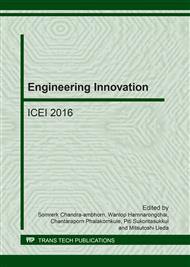p.149
p.155
p.160
p.166
p.172
p.181
p.187
p.193
p.199
Influence of Spray Drying Conditions on Particle Size and Morphology of Al2O3/ZrO2(3Y) Composite Particles
Abstract:
Zirconia toughened alumina materials are frequently used in biomedical applications due to their enhanced toughness, strength and wear resistance compared to monolithic alumina. In this work, the influence of spray drying conditions is studied on the characteristics of spray-dried Al2O3/ZrO2(3Y) composite particles. The SEM images of composite particles confirm the formation of dense composite particles of round shape without internal holes. The particles of the best morphology of the median diameter of 44 µm were produced by drying the slurry of 70 wt.% solid content with feed rate of 15 ml/min using the drying air with inlet temperature of 210 °C and spraying air with flow rate of 357 l/h.
Info:
Periodical:
Pages:
172-177
Citation:
Online since:
January 2017
Authors:
Price:
Сopyright:
© 2017 Trans Tech Publications Ltd. All Rights Reserved
Share:
Citation:


